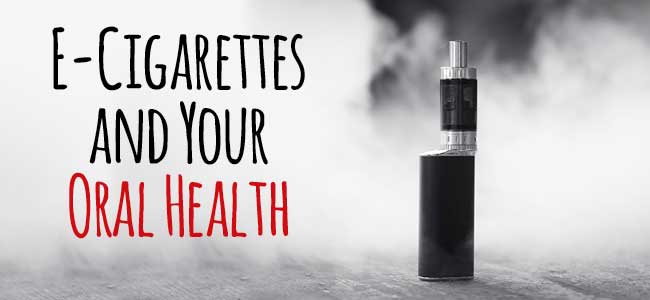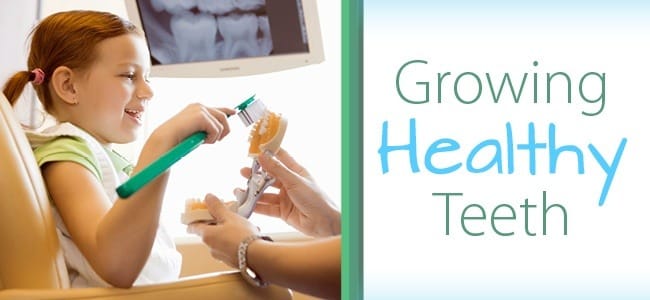E-Cigarettes and Your Oral Health: The Smokeless Threat to Your Smile

For many smokers, e-cigarettes seem like the best answer to avoiding the nasty side effects of smoking traditional cigarettes, including the odor and the staining of teeth, skin, and clothing. Though e-cigarettes still contain the highly addictive chemical nicotine, tobacco and other harmful elements are eliminated from the electronic smoking process, or what some refer to as “vaping.” The growing popularity of e-cigarettes and vaping, especially among young people, has caused a rise in concern over the lack of knowledge around the effects it has on health. While clinical studies are currently underway, in 2014 the U.S. Food and Drug Administration (FDA) released a statement saying “e-cigarettes have not been fully studied, so consumers currently don’t know the potential risks of e-cigarettes when used as intended, how much nicotine or other potentially harmful chemicals are being inhaled during use, or whether there are any benefits associated with using these products.” Vaping has a direct effect on oral health. Exposure to e-cigarette aerosol can lead to an increase of bacteria in the mouth, which is associated with gum disease, cavities, and tooth decay. The flavoring added to many e-cigarettes can also lead to cavities, not to mention an increased chance of developing chronic lung diseases. It can also cause dry mouth, inflamed gums, and other issues dentist are able to speak to how these new smoking devices threaten your oral health. Nicotine is harmful to your teeth and gums, even in the absence of tobacco and other chemicals traditionally found in cigarettes. Electronic cigarettes still deliver nicotine to their users through the mouth, throat, and lungs. The following are some of the consequences that come with using smokeless cigarettes. Gum Disease: One of the highest risks of e-cigarettes is an increased risk of gum disease coming from three specific conditions. Nicotine leads to Vasoconstriction, which is the limiting of the blood supply to the gums. When the blood supply to your gums is reduced it makes the more susceptible to infection and can lead to gum recession. Gum disease is caused by plaque bacteria. Smoking dries out your mouth, creating an environment that is more conducive for bacteria growth. Your immune system is weakened as a result of smoking, so infectious diseases can develop at a faster rate. It’s important to note that in addition to the problems caused by vasoconstriction one of the telltale signs of gum disease is swelling of the gums caused by irritation. When nicotine reduces blood flow, preventing swelling, this indication of gum disease can be masked, causing your dentist to miss the symptoms and allowing the disease to progress. Gum Recession: Lack of blood flow to the gums keeps the tissue from receiving the nutrients it needs to survive. Over time the skin dies and recedes. Bad Breath: Nicotine restricts your body’s ability to produce saliva, which makes your mouth vulnerable to harmful bacteria and tooth decay. Combined, dry mouth and bacteria lead to halitosis, which can be embarrassing and can affect your self-esteem. Intense Grinding: As a stimulant, nicotine causes muscles to tighten and spasm against the user’s will. It can cause sleep disturbances such as insomnia and grinding of the teeth. Grinding, especially while sleeping, can be damaging to teeth and result in the loss of tooth enamel, as well as chipping, cracking, and breaking of teeth. If you want to maintain your best oral health, avoiding any type of smoking is recommended. If you do choose to smoke, keeping it to the minimum and maintaining your best at-home oral hygiene practices as well as your routine visits to the dentist is important. If you see signs of periodontal disease (including red, swollen, bleeding, or receding gums) or experience bad breath, painful chewing, or loose teeth, make sure to contact your dentist immediately. There are treatments you can receive that will help keep your teeth and gums in the best possible condition. Two such treatments include: Professional dental cleanings Plaque and tartar are removed from above and below the gumline. If you have gingivitis or signs of periodontitis, you will be required to have this level of cleaning twice a year or more. Scaling and root planing Plaque and tartar are scraped away from both above and below the gumline while under local anesthetic (scaling). Rough spots on the tooth root are then smoothed out (planing). Locally applied medications, such as antimicrobials and antibiotics, may be used. If you are experiencing jaw tightness or pain, and you think you might be grinding your teeth, your provider can fit you with a mouthguard that will protect your teeth while you sleep. It can be difficult to share your habits with your dentist. At AV Sierra Dental Center, we treat our patients with respect and compassion. We are here to help you be your healthiest self. If you use e-cigarettes and are concerned about how they may be affecting your oral health, call us today and set up a consultation. We will help you protect your teeth and maintain your natural smile.
The Ages & Stages of Your Child’s Dental Health

Few parents realize that their children are at risk for tooth decay from the moment the first tooth appears (around 6 months). Even though baby teeth are temporary, they are important; they serve as placeholders for adult teeth, and if they are lost too early, their adult replacements may grow in too early and affect the position of permanent teeth that come in later. Tooth decay and damage can also lead to issues with speech development that require therapy for correction later in life. Pediatric dental disease is the number-one chronic childhood illness, and it continues to plague children throughout the course of their development and into their adult years — but it doesn’t have to. Teaching children good dental habits at an early age and making sure they attend routine dental visits goes a long way toward helping them maintain a pain-free, healthy, and beautiful smile for a lifetime. The following information functions as a road map for understanding your children’s oral development and health throughout their ages and stages. Birth to 1 Year You should be caring for your baby’s teeth before they even appear. Infant toothbrushes come in a variety of sizes and shapes. Most are made out of a soft BPA-, lead- and phthalate-free silicone and have tiny bristles parents can use to gently brush gums after each feeding. Once your baby is old enough to sit and hold objects, there are similar brushes that resemble teething rings, which babies can hold and massage their own gums with. Your child should have his or her first dental exam by the time they are 1 year old. When Baby’s First Tooth Appears As soon as baby’s first tooth appears, you should begin brushing with the infant toothbrush and water twice a day. Sugars are detrimental to teeth, and too much can quickly lead to tooth decay. Try to limit your child’s juice intake to one cup a day. Also, be aware of your child’s sucking behaviors and habits. If your baby sucks his or her thumb, finger, or pacifier, now is a good time to start planning out how you will break the habit. Regular sucking can negatively affect your child’s bite. Your pediatrician will inspect your child’s teeth at each well-child exam and will refer you to a dentist should any concerns arise. You should consult with your pediatrician about fluoride, sealants, and additional ways you can support your child in the development of excellent oral hygiene habits. 2 to 5 Years By the time your child is 2 and a half, they should have all of their baby teeth. At the age of 2, your child is ready to start learning how to brush their own teeth two times a day. Soft-bristled, child-size toothbrushes are available and make reaching difficult spots easier for uncoordinated little hands. At this age, your child can use a pea-size amount of toothpaste with fluoride. Allow them to brush their own teeth for a couple of minutes, then finish by taking the brush and making sure every tooth has been gently scrubbed. Once you are finished, have your child spit the remaining toothpaste into the sink. Tips for Avoiding Toddler Tooth Decay Avoid sugary snacks and drinks. If your child needs milk or formula before bedtime, make sure to rinse their mouth out prior to laying them down. If your child requires a bottle at bedtime, fill it with water. 6 to 11 Years Your child will start losing their primary teeth around 6 years. They will continue to lose primary teeth and gain most of their permanent teeth until around the age of 13, when they should have 28 permanent teeth. Once the teeth start to touch, regular flossing becomes more important. Children often have trouble brushing the gumline or the back teeth, so parents will need to focus on these problem areas. Almost 90% of cavities in permanent molars occur in the grooves. Dental sealants, can help protect your child’s teeth by placing a thin coating over these high-risk areas. Dental injuries are very common during this period due to sports, 12 to 18 Years Most children have lost all of their baby teeth by the age of 12 or 13. If there is enough room, their final teeth — the wisdom teeth — will erupt around the age of 17. If your child’s dentist believes room is limited, he or she may recommend that the wisdom teeth be removed. Teens also tend to see more cavities than any other time of life. Most of the time this has to do with questionable diet choices and less than adequate oral hygiene practices. Children may also become more self-conscious if they have crooked or discolored teeth. Now that the permanent teeth are in place, it’s common to have conversations about teeth whitening and getting braces to straighten teeth. Orthodontia has come a long way, and treatments don’t have to take place late in life, nor do they take as long. With the right oral hygiene habits and the proper dental care, your child can have a beautiful, healthy smile well before they walk down the graduation aisle. A variety of dental issues may arise throughout the course of your child’s development. Regular dental visits will ensure that they are caught and dealt with early. For more information about how to care for your children’s teeth as they grow, call our Palmdale CA Dental Office today. We are here to ensure that your most precious family members enjoy a lifetime of beautiful, healthy, and happy smiles.
